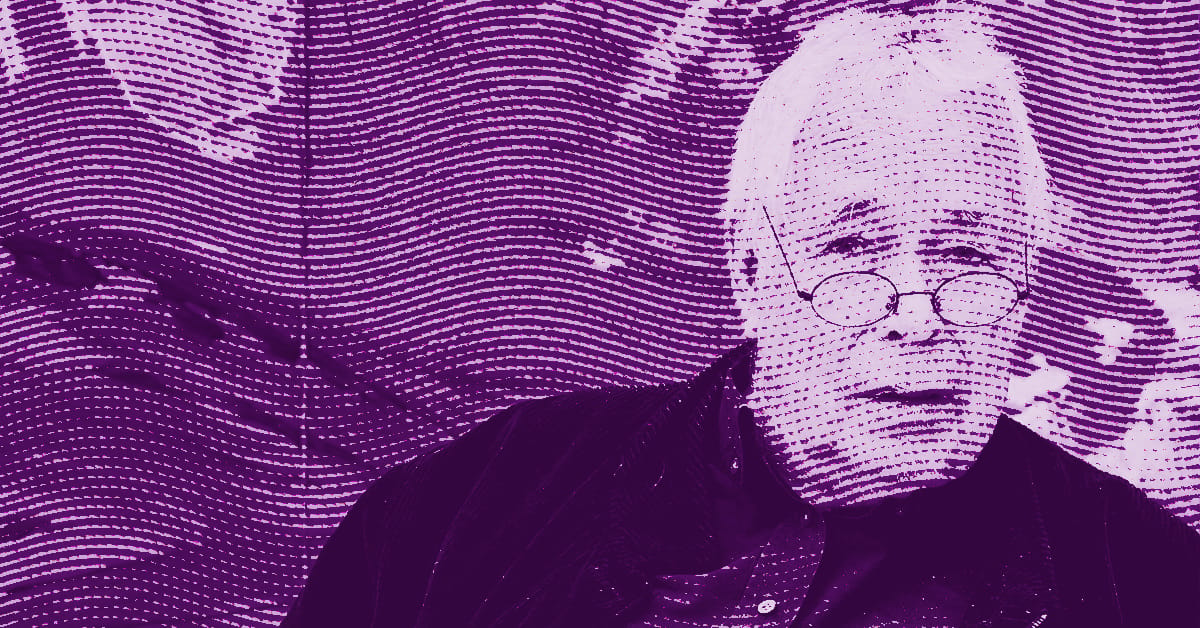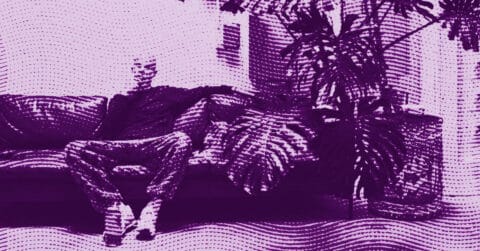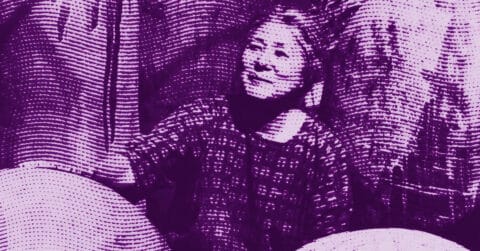Listen to me carefully, you bunch of snobs, here is a painter who spent his life lying to us with disarming honesty. Howard Hodgkin, this Englishman born in 1932 and died in 2017, this baronet of the brush who collected honors like others gather fallen leaves, never stopped claiming that he did not make abstract art. What audacity. Look at his paintings: splashes of turquoise, streaks of orange, masses of green that overflow on the frames like an unruly tide. And yet, he protested. No, he said, I paint emotional situations. I paint memory. As if memory ever looked like a paint stain on plywood.
But precisely, that is where the perversity of his enterprise lies. Hodgkin gave us paintings that are both everything and nothing, that promise stories and deliver only sensations, that carry titles like Waking up in Naples or In a French Restaurant and show nothing but the impossibility of showing anything. He built an entire body of work on the gap between what can be said and what can be painted, between memory and its representation, between desire and its satisfaction. A painter of lack, then, disguised as a joyful colorist.
His technique itself betrays this obsession with control and loss. He painted on wood, never on canvas. Why? Because, he said, “wood responds” [1]. Canvas would give way, deform, sag under the weight of his reworkings. For Hodgkin was a slow painter, terribly slow. A single painting could take him years, successive layers of paint applied, scraped, covered, until the object became a piling up of elapsed time. Each surface bears the trace of this struggle, of this desperate search for something that always escapes.
And then there are these frames. Hodgkin did not merely frame his works: he overflowed them, invaded them, colonized them. The paint ran over the frame, making it an integral part of the image. Some saw in it a metaphor for overflowing emotion, for passion that cannot be contained. Others, more pragmatic, saw a decorative process, a coquettishness. But this gesture reveals above all a deep anxiety: that of delimitation, of the border between the work and the world, between inside and outside. As if he sought to protect his images from intrusion, from a gaze that would impose its own frames.
For Howard Hodgkin was a man inhabited by nostalgia and secrecy. A homosexual married for years, father of a family before daring to live with his companion Antony Peattie, collector of Indian miniatures, compulsive reader of Agatha Christie detective novels, he led a compartmentalized, sectioned existence. His paintings, purportedly autobiographical, reveal nothing. Or rather, they reveal the impossibility of revealing. They are closed doors, fogged windows, half-closed shutters on interiors that we will never really see.
The poetry of the almost-said
Hodgkin was a great reader of poetry, and it is in this relationship he had with literature that perhaps best outlines the nature of his pictorial project. When asked which poets he read, he replied Stevie Smith, that offbeat 20th-century Englishwoman who wrote verses of apparent simplicity, almost childlike, but filled with a heartbreaking melancholy. The parallel is enlightening. Stevie Smith, like Hodgkin, practiced an art of deceptive sparseness, a constructed naivety that concealed abysses. His most famous poem, the one that evokes someone drowning but believed to be waving their hands, could serve as a preface to Hodgkin’s entire work.
This affinity with poetry is not trivial. It profoundly structures his approach to painting. Seamus Heaney, during a Hodgkin exhibition in Dublin in 2006, cited Philip Larkin and his poem The Trees, those trees whose new leaves look like “something almost said.” The almost-said: that is exactly what Hodgkin tried to capture. Not the said, not the shown, but that trembling moment just before articulation, that shiver preceding speech or image. For Hodgkin, memory was never clear, never sharp. It was mist, impression, diffuse color. It was the opposite of documentary precision.
That is why he vehemently refused to have stories told behind his paintings. Critics, always eager for reassuring narratives, wanted to know: what happened in Naples that morning? Who was sitting in that French restaurant? Hodgkin evaded. Not out of affectation, but because he knew the narrative would kill the painting. Once the anecdote was revealed, the painting would be nothing but an illustration, a footnote to a life. But what he sought was precisely the opposite: to make the painting an event in itself, an experience that does not need the story to exist.
This stance is deeply poetic. Poetry, more than any other language art, resists paraphrase. You cannot summarize a poem; you can only read it, again and again, experiencing its rhythms, its sounds, its silences. Hodgkin’s paintings function in the same way. They do not want to mean anything; they want to be felt. Their meaning is not decipherable; it is sensitive. Saying that a painting represents an absent friend or a sunset in Bombay teaches us nothing about what the painting does, about how it operates on our gaze and our body.
The titles themselves participate in this poetics of indirection. They do not describe; they suggest. They open paths that the image neither confirms nor denies. They create tension, a gap, a play space between words and forms. Absent Friends, for example, this 2000-2001 painting that gave its name to a posthumous exhibition: a few broad strokes of black, brown, turquoise. Is absence visible there? No. But the title summons it, and suddenly these colors are charged with sadness, with lack. The title acts as an emotional filter; it colors our perception without determining what we see.
This practice of an evocative but non-descriptive title recalls certain techniques of modern poetry. The title becomes a threshold, a gateway through which one enters the work without exactly knowing where one is going. It creates an expectation that will never be fully satisfied. And it is precisely in this incompletion that the strength of the work lies. Hodgkin painted from memory, but a fragmentary, gap-filled, uncertain memory. He did not seek to reconstruct the past but to capture its affect, its emotional tone. In this, his work is close to that of Proust, another great explorer of involuntary memory, of those moments when the past resurfaces not as a coherent narrative but as raw sensation.
But unlike Proust, who unfolded infinite sentences to grasp these fleeting moments, Hodgkin compressed, synthesized, reduced. His paintings are color haikus, visual epigrams. A few brushstrokes, and a whole world appears and disappears. This economy of means, this ability to suggest immensity with the minimum, is yet another lesson in poetry. The great poem is not the one that says everything, it is the one that leaves the most room for silence, for what cannot be said.
The architecture of withdrawal
The other key to understanding Hodgkin lies in his relationship to space, to architecture, to the place of creation. His London studio, located at the back of his Georgian house in Bloomsbury, is an extraordinary space. A former 19th-century dairy, it was transformed in 1991 into an entirely white sanctuary. White walls, white floor, translucent glass ceiling diffusing uniform light, without shadows. A space of nearly three hundred square meters emptied of any distraction, of any color. Architect Robert Barnes had designed a roof using millions of glass tubes to create constant brightness, whatever the weather [2].
This absolute whiteness is not accidental. For a painter famous for his chromatic explosions, the choice to work in such a stripped-down environment is a revealing paradox. Hodgkin needed this void, this neutrality, this absence. He said that the light in his studio was like an envelope. A protective envelope, but also an envelope that contains, that delineates, that separates inside from outside. The studio was for him a retreat in the monastic sense of the term, a space of radical solitude where he could confront his images without mediation, without interference.
This conception of the studio as a sacred, almost liturgical space says a lot about his practice. Hodgkin never painted with music, never surrounded by the objects he passionately collected. Just him, the white light, and the painting in progress. This asceticism was necessary. Painting, for him, was an act of extreme concentration, a form of painful meditation. He spent more time sitting looking at his paintings, waiting for the right moment to intervene, than actually painting. This patience, this ability to do nothing, was at the heart of his process.
The space of the studio also functioned as a sensory isolation chamber. By eliminating all external stimulation, by creating a sort of void, Hodgkin could focus on interior images, those that emerged from his memory. The whiteness of the studio was the screen on which his memories were projected. It was the blank page before writing, the silence before music. This whiteness was not an absence but a potentiality, an infinite reservoir of possibilities.
There is something deeply architectural in the way Hodgkin constructed his paintings. The frames, as we said, were an integral part of the work. But beyond this gesture, his entire composition stems from architectural thinking. His paintings create spaces. Not illusionistic spaces, windows open to a fictitious world in the Renaissance manner. No, real, physical, three-dimensional spaces. The wood on which he painted is not a transparent support but an object, a thing that has its weight, materiality, its presence.
This materiality is essential. Hodgkin insisted that his paintings had to be above all objects, things that exist firmly in the world. This solidity was necessary because everything else, memory, emotion, meaning, was so unstable, so fluid. The painting as an object was an anchor point in a world of flux. It was minimal architecture, a shelter against the evanescence of time.
The frames, by overflowing, created a transitional zone between the image and its environment. They acted as thresholds, porticos, door jambs. One thinks of the architecture of John Soane, whom Hodgkin deeply admired. Soane, that neoclassical visionary, master of light effects and intertwined spaces, created interiors where each room opened onto another, where mirrors multiplied perspectives, where one never really knew exactly where one was. This spatial complexity, this dissolution of clear boundaries between inside and outside, between one space and another, finds an echo in Hodgkin’s paintings.
The exhibition of his prints at Soane’s Pitzhanger Manor from October 1, 2025 to March 8, 2026 is no coincidence. There was a deep affinity between these two creators of spaces. Both worked on the idea of enveloping, framing, staging the visual experience. At Soane, circular openings, vaults, niches created successive frames that guided the gaze. In Hodgkin, painted frames, overflowing edges, overlapping color planes created similar effects of depth and mystery.
This architectural dimension of his work is also linked to his obsession with interiors. Hodgkin was a born decorator, a creator of atmospheres. His Bloomsbury house was famous for its refined eccentricity: hundreds of copies of the same book bound in green and red to cover a wall and absorb noise, lampshades made of cheap white plastic bags to achieve the most diffuse light possible, chairs from all eras and all styles arranged with maniacal care. Every detail counted, participated in creating a controlled environment, a space where everything was calculated.
This obsessive attention to decor, far from being superficial, reveals a deep concern: that of the relationship between the individual and their environment, between the self and what surrounds it. Hodgkin’s interiors, whether painted or lived in, are never neutral. They are charged with memory, ghostly presences, residual emotions. A painting like Grantchester Road evokes the house of a friend architect, but what is seen there is not a faithful representation. It is an impression, an atmosphere, the feeling of being in this space at a given moment. Architecture becomes affect.
The paradoxical legacy
What remains, finally, of this enterprise? Precious objects, certainly, which sell for a high price and adorn the walls of museums. But above all, perhaps, a lesson on the impossibility of restitution. Hodgkin spent his life trying to paint what cannot be painted: the passing of time, vanished friends, faded emotions. He failed, magnificently. His paintings capture nothing, they fix nothing. They merely point to what is missing, what has been lost.
His friend Patrick Caulfield, visiting his own retrospective, cried while repeating “not enough, not enough” [3]. Hodgkin recounted this anecdote with palpable emotion, because it was also his own feeling. Never enough. Never quite right. Always a gap between intention and result, between memory and its pictorial translation. This chronic dissatisfaction, far from being a weakness, was the driving force behind his work.
Toward the end of his life, curiously, his paintings became stripped down. Fewer layers, less material, more emptiness. As if, after decades of struggle, he had understood that the less one says, the more accurate one is. That silence can be more eloquent than speech. These last works, with their few brushstrokes on bare wood, attain a form of wisdom. They no longer pretend anything. They simply exist, modest, fragile, moving.
Death surprised him in 2017, at eighty-four years old, while he was still preparing exhibitions. One can imagine he would have continued indefinitely if his body had allowed it. Not out of ambition but out of necessity. Because painting, for him, was not a choice but a condition of existence. A way to inhabit time, to face inevitable disappearance. His paintings are monuments to the ephemeral, architectures for the intangible. They celebrate what flees while trying to hold it back, knowing that this attempt is doomed to fail. And it is precisely in this assumed failure that their beauty resides.
- Veery journal, cited in Wikipedia, consulted on November 5, 2025, during documentary research.
- Robert Barnes, Letter to the Editor, London Review of Books, Vol. 43 No. 13, 1 July 2021.
- Charlotte Burns, “Howard Hodgkin: ‘I felt like an outcast in the art world'”, The Guardian, 4 May 2016.
















